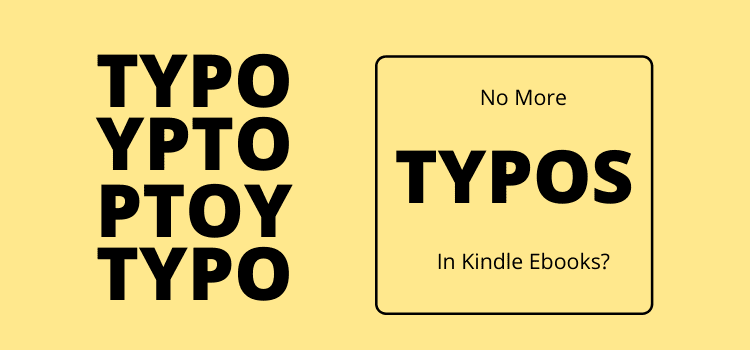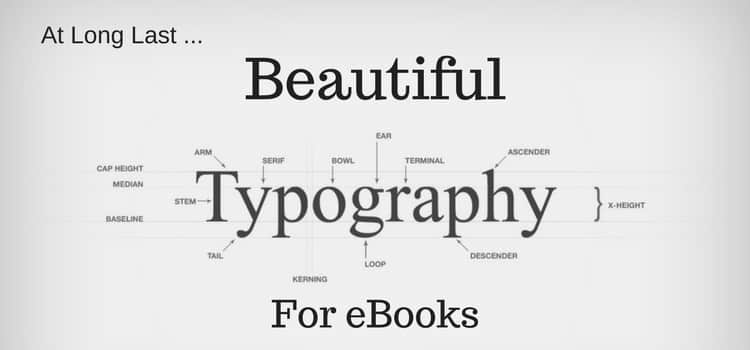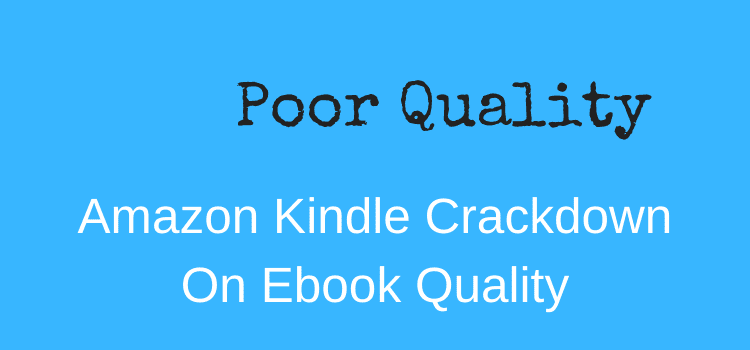
Typos in Kindle ebooks can happen.
Perfection is difficult, no matter how carefully you prepare your book for publishing.
However, some help is at hand.
And it comes from a surprising source: Amazon.
KDP to the rescue
I was delighted to get an email from Kindle Direct Publishing (KDP) pointing out that it had found three typos in one of my Kindle ebooks.
Hello,
We’re writing to let you know that readers have reported a problem in your book.
There are some words in your book that our spell check dictionary could not identify.
If any of the words are not spelled the way you intended, please update your content and resubmit it to us.
You can also email us at kdp-support@amazon.com to let us know that the words are spelled correctly. Here are the words and their locations:
Kindle Location: 6866 ; Description: “there where times when” should be “there were times when”
Kindle Location: 7298 ; Description: “heart is was called” should be “heart it was called”
Kindle Location: 6967 ; Description: “thorn is the side” should be “thorn in the side”
After you’ve made the correction, please upload your revised content through the ‘Book Content’ section in your KDP Bookshelf. If you have further questions, please reply directly to this email and we’ll get back to you as soon as we can.
For further information regarding specific book errors (including why some errors are more critical than others), please see the Guide to Kindle Content Quality Errors at https://kdp.amazon.com/self-publishing/help?topicId=200952510.
Thanks for using Amazon KDP!
Any means to rid typos in Kindle ebooks is a good thing
I was a bit surprised, though, because I published this particular ebook quite some time ago.
But in some way, it was a relief because this book is nearly 170,000 words long. So, three typos are not so bad in a book that long.
When I published it, I worked extremely hard to ensure it was perfect and free of typos.
But for KDP to let me know, it means it is getting more serious about improving the quality of Kindle ebooks.
It was interesting to note in its email that it states that readers had reported the errors.
I’m not sure how this works, as eliminating typos is good news, but why rely on readers?
KDP has a spell checker that analyses a new manuscript when uploading. It notifies authors of possible spelling errors before publication.
However, adding contextual correction would be a big plus, and it is something that other online publishers should consider.
Is there a better way to catch typos in ebooks?
The only point that I wonder about is why Amazon relies on reader notifications to find these contextual typos on KDP.
Many online AI proofreading programs do an excellent job of finding contextual typos.
Why doesn’t KDP use something similar to scan new manuscripts and find these typos before publishing?
Anything that helps eradicate typos in self-published books is a good thing.
But I genuinely hope that KDP and other online publishers can find a way to do this before publication and not rely on readers to notify them of typos they find.
Typos elsewhere
For hardworking, self-published authors, there is hope. It’s only a typo!
You are not alone in trying to perfect your ebook manuscript.
Perhaps you are working even harder and making a better fist of it than some of the big publishers at removing every single typo.
While reading two separate posts on Forbes and The Verge regarding the annoyance of typos in ebooks, it was reassuring in some respects to note that the brunt of the complaints was directed at large publishers.
However, as I read the long list of comments on these posts, one piece of information caught my attention.
The new information I found interesting was in this comment. I quote:
GAP ebooks: an explanation for why they are so shoddy.
I’ve just learned that the production AND PROOFREADING for Bantam/Spectra ebooks is done…. By people who barely speak English. (Apparently, this applies to every ebook published by the conglomerate, which includes Bantam.)
If this is true, it says a lot about outsourcing quality control in publishing to the cheapest contractor.
Another practice is using OCR (Optical Character Recognition) to convert backlisted manuscripts to electronic files.
Anyone who has had any experience with OCR knows it is a process that is far from perfect. A quote from the Forbes article:
Unacceptable or not, that’s what someone has done. Simply OCR’d the printed text and not subbed *sic (sub-edited) it through again.
I shudder to think about the result, as my experience with OCR has been that the result always contains character errors on every page.
Poor quality control
While these two areas gained a mention, along with the obvious blame on poor editing, sub-editing, and proofreading, the one missing reason for ebook errors is the process itself.
You can prepare a final text in HTML, docx, RTF, pdf, epub, and other file formats. However, it will then be converted into the ebook files used by each ebook distributor or retailer.
Kindle, Apple, Smashwords, and all the other platforms use a variety of ebook formats. Even the most perfect text can fail during these file conversions.
In other words, the words of the text need to be converted into ones and zeros and then converted back into text. And rarely perfectly.
This differs entirely from the technique for a printed book. All of the text is reproduced using photographic processes and, therefore, prints exactly as intended.
From my experience, when I download copies of one of my ebooks from different sources, they are never exactly the same.
The most common problems are formatting changes, italicized text removal, replacement or misinterpreting accented characters, and random changes to fonts and paragraph styles.
Quite honestly, most conversions are reasonable, but some are problematic. It can occasionally make a difference if the file preparation uses Apple or Microsoft programs.
Some ebook conversions may not work quite as well with Apple word processing programs.
Or if they do, they can still add code and spaces (sometimes seen as Apple Space in code) that can affect formatting styles.
Summary
I am sure the great debate about typos in Kindle ebooks will continue.
But it is worth noting that some of the complaints about authors, poor proofreading, or poor formatting could be the fault of the ebook process itself.
Most authors work very hard in the preparation of their ebook manuscripts.
So, it’s not always the fault of the author.
E & OE
Related reading: Amazon takes action over poor quality in Kindle ebooks.
Share This Article



I don’t think I’ve read a single Kindle book which didn’t have at least one typo.
It’s pretty trying when it’s a book such as _Dune_ which has had a lot of readers even in the e-book version and it’s a word which actually changes the meaning of the passage (program for pogrom).
I pretty much don’t bother reading fiction on the Kindle unless I already own a paper copy so that I can check it for errors — at least non-fiction one can intuit meaning and what would be correct.
I’ve just been reading a Kindle book which has more errors in it than all the other hundreds of ebooks I’ve read. It’s plainly been scanned, but no one has bothered to check it. Apart from typos, there are innumerable formatting problems:
1. Letters that were in a different font at the beginning of a chapter, or section, not only appear as garbage, but the original capitalized letter may turn up several Kindle pages further on. (It took me a while to cotton onto this.)
2. Whenever poetry is quoted, there are additional lines between the original lines, and in one case towards the end, the rest of the ordinary text has turned itself into ‘poetry.’
3. Quotation marks are random, sometimes appearing, sometimes not. Sometimes they’re replaced by asterisks, or some other punctuation sign.
4. There are large chunks of white space where there should just be the next line in the paragraph. In one case there’s almost a whole Kindle page blank.
5. Sometimes after a break in the lines, the next section becomes incomprehensible, as though there were actually some words missing.
That may not be everything. But it became impossible to keep on informing the publisher – Amazon Digital Services LLC, apparently – about each and every mistake. There would be at least one per page, if not several.
The only surprise was that I managed to read the book completely, in spite of all the errors.
The worst offenders I know of are maths books; for example “The Calculus Lifesaver” has a host of idiotic errors,, and various efforts from Schaum are even worse
There is a way for readers to report typos, but probably it’s too obscure and only the most determined will stop to do it rather than continuing to read.
I like the free classics available on Kindle, but the typos are abundant and really annoying. Of course this is because the books are simply scanned, not written (typed) by an author. I sometimes wonder if there would be a good market for classics that have been carefully proofread and corrected. How much more than zero would readers be willing to pay? I’m a great proofreader and wouldn’t mind this as a small business–if it worked! Any votes for the first classic (public domain) book I should try? :)
170,00? Your book is one-hundred-and-seventy-hundred words long?
Yes, it is! Well, in fact 167,148 to be precise.
I think you missed the point of S.A. Hunt’s comment. LOL! You are missing the final zero in your post, which means it reads as “one hundred seventy HUNDRED words,” instead of “one hundred seventy THOUSAND words.” Change 170,00 to 170,000 and you’ll be golden!
Yep, you are right. I missed it. But not any longer. My typo, my fault. But now corrected.
I understand why you would wonder about Amazon using readers to proof read books, however as an avid kindle reader I like the option. I often make highlights and notes while reading so it is no extra work to report typos. I think of it as volunteer work in an online Library.
Interesting idea, and I have no problem with such scrutiny. In fact, as a writer, I’d appreciate such detailed and free copy editing. One point, though: I work in fantasy, among other genres, and many of my stories contain characters and places with invented names. It will be interesting to see how this process copes with such idiosyncrasies.
That’s funny. Where did my comments and replies therein go?
Moderator: Sorry, they got lost on our domain move. Here they are.
The funny thing to me is, even if Amazon did run a spell checker on submitted e-books, it probably wouldn’t have caught your book’s typos because the typos all produced words that were nonetheless in the dictionary. Since “in,” “is,” and “where” are all real words, even though they were supposed to be “it,” “it,” and “were,” they would have passed a spellcheck.
Be that as it may, why not rely on readers? If a reader notices a typo and is irritated enough to report it to Amazon, why shouldn’t they do something about it?
I think that it would be a great idea for Amazon to incorporate typo reporting directly into their e-readers. If they can synchronize page position, highlighted passages, and so forth, why not let a reader long-tap on a word and choose “report typo”? They could have someone check each report to make sure it really is one, then aggregate the actual ones and send that off to the publisher (be he corporate or self). Even if most didn’t bother, the thousands upon thousands of actual human readers who did would make a far better way to catch typos after the fact than a spellchecker…
Sorry about losing your comments, Chris. We moved our website to a new hosting, so we had a few gremlins appear during the few days it took to complete the move. Hopefully all is well now though.
Your Kindle eInk devices have a feature called Report Content Error that allows you to report content issues in the book. The feature is not currently available on other reading surfaces like Tablets and phones.
You can reach the feature by long pressing a word, selecting more from the pop-up menu. You should see Report Content Error option on your screen. All valid errors are surfaced to publishers and authors for correction.
Thanks for your comment. I read Kindle content on my PC and laptop, and this is exactly the feature that I used to use but is no longer available. Keep on reading!
I found at least two typos in this blog post.
1. “. . . pointing out that they had found a three typos in one of my books.”
2. “The only point that I wonder about is why Amazon rely on reader notifications . . .”
Number two may simply be British usage for collective nouns, but to an American ear/eye, “Amazon relies . . .” would be correct.
As for your question about reader-detected typos, Kindle has a feature that allows readers to highlight a word or phrase and then select a menu item to report errors. Unfortunately, e-books are typically riddled with typos. Maybe it’s only because I am a professional editor, but I always report even small errors using this feature.
Thank you for your comment, Joseph. Point taken and corrected for the first, but yes, I think the second is my British English usage where organisations or companies can be either plural or singular. So “the government have, or the government has” would both be correct.
Re: correction feature. I believe this has been discontinued. I cannot send corrections to my latest ebook purchase, ( which is riddled with errors), and when I look into older purchases in which I know I used this feature, it seems to no longer exist.